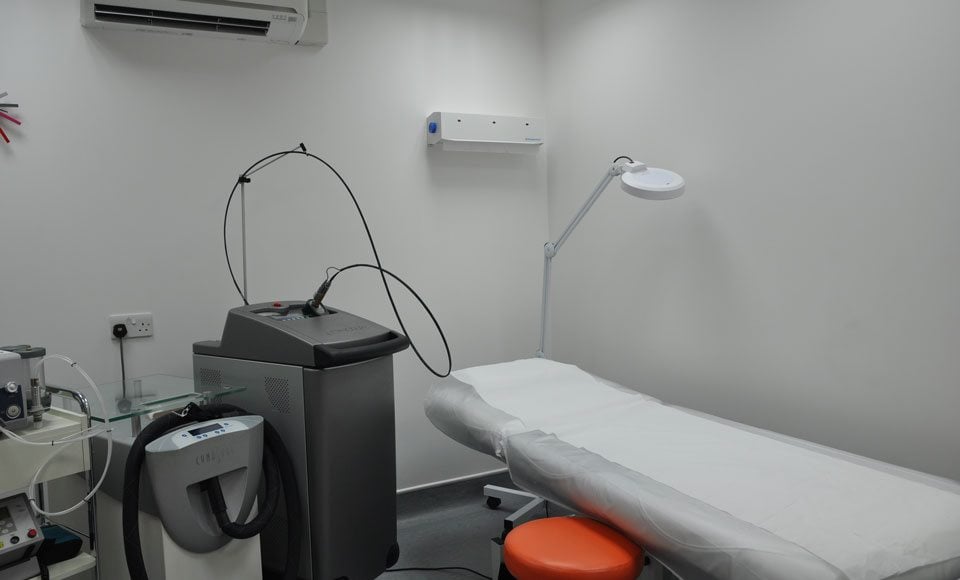Whether you’re a bodybuilder looking to show off his hard-earned lats, a swimmer who needs more aerodynamic limbs, or just a guy who wants to feel better on the beach, odds are you’re no stranger to hair removal.
We’ve covered various ways to deal with your tufted troubles, from plucking to shaving to creams. All are workable short-term options, but if you’re done with the fuzz for good, there’s one treatment to rule them all: laser hair removal.
Grooming’s most high-tech hair solution can seriously reduce your winter coat, with minimal pain and no downtime. It’s not your cheapest option, but it sure beats suffering while Helga gives you the 40-Year-Old Virgin treatment once a month.
All your burning laser hair removal questions answered, below.
What Does The Laser Actually Do

If the thought of blasting your neck or naughty bits with red hot laser beams makes you uneasy, rest assured it’s a safe and commonplace procedure. Laser technology emits a very specific beam at a wavelength that targets the pigment, called melanin, in hair follicles. The laser passes through the skin with little discomfort to destroy the follicle itself, thereby stunting or ending hair growth in that area.
Am I A Dood Candidate
Because the laser is calibrated to target melanin, only certain hair and skin tones can effectively be treated. Insufficient melanin in the hair prevents the laser from finding the follicle, while an abundance of melanin in the skin can mean the laser targets the wrong area.
The best candidates for laser hair removal have fair skin and dark hair. In more recent years, new lasers have been developed that can safely treat dark skin without causing a burn. For redheads, blonds, and silver foxes, electrolysis may be a better option.
What Areas Can I Laser

Where there’s hair, there can be laser. Your neck, your back, your chest, your beard, your unibrow, your Frodo feet… it’s all fair game (yes, even the sack and crack). The only limit is your comfort level, though you may want to do a patch test first to assess your sensitivity to the procedure.
Where Should I Have It Done

Regulations regarding who is legally allowed to administer the treatment vary by location, so be sure to do your research before committing. In some states laser hair technicians are required to work in medical facilities with physician supervision, for example, while in others technicians my open their own practices or work in salons and spas. Also look into whether an esthetician is legally allowed to perform the procedure, or whether it must be a registered nurse or physician’s assistant.
How Do I Prepare

Laser hair removal is safe and effective in part because of how you prepare. DO NOT attempt the treatment if you have a tan – including a faux glow – as the laser can mistakenly target the pigment in your skin. Tanning is the most common cause of blistering after laser treatment. Additionally, avoid plucking, electrolysis, waxing, bleaching or depilatories for at least two weeks prior to treatment. The hair must be present and its natural colour in order to be treated. Shaving is fine up until a day or two before your appointment. If you’re taking any antibiotics or medications, inform your provider prior to treatment and consult your doctor about any contraindications.
Does It Hurt

Everyone wants to know exactly how much pain they’re signing up for, but the answer is unsatisfying: it depends. It won’t feel like nothing, but unless your pain tolerance is exceptionally low, it shouldn’t be unbearable either.
The sensation is something like a rubber band snapping against your skin, or the shock of an electrically charged doorknob. In other words, it’s uncomfortable, but brief. And you know what they say about pain and gain. Some providers have topical numbing creams or cooling machines for particularly sensitive patients.
What About Afterwards

Much like botox, laser hair removal is a “lunch break” procedure. There’s no downtime following a session, and you should experience minimal – if any – pain. Your provider should offer aftercare advice, including suggesting a topical treatment to soothe irritated skin if necessary. If they don’t automatically provide post-procedure tips, ask.
Are There Any Side Effects

Many clients experience no side effects, but as with any cosmetic procedure, the risk is not zero. It’s normal to experience redness, sensitivity, or itching for 24 hours after treatment. Alert your provider if irritation lasts longer. Clients with more severe reactions may experience mild to moderate burns or blistering, changes to the pigmentation of the skin, swelling, rashes, bruising, or follicular edema. Permanent scarring is rare.
How Many Treatments Will It Take
The number of visits required for significant hair reduction varies. Some patients require only four, others require eight. Expect to fall somewhere in that range. As men typically have denser hair with thicker follicles, a male client will likely require more treatments than a female client. Once the bulk of the treatment is successfully completed, you may also require a maintenance appointment once or twice a year.
How Much Will It Set Me Back
Costs are assessed based on the area being treated, with large areas naturally costing more than smaller ones. An average back treatment, for example, could run you anywhere from $200-$400 per session. Multiply the price by six to eight to estimate the total cost to become hair-free. Many providers offer packages to make laser hair removal more affordable.
Is It Really Permanent
Though we call it laser hair removal, laser hair reduction would be a more accurate name. Complete hair removal cannot be guaranteed – in fact, a small percentage of patients don’t respond to the laser at all – but the vast majority will walk away with nearly permanent results. Don’t slack on completing your initial appointments at regular intervals, and use annual maintenance sessions to keep you looking fresh, not fuzzy.
RELATED: The Beginner’s Guide To Dealing With Unwanted Body Hair
